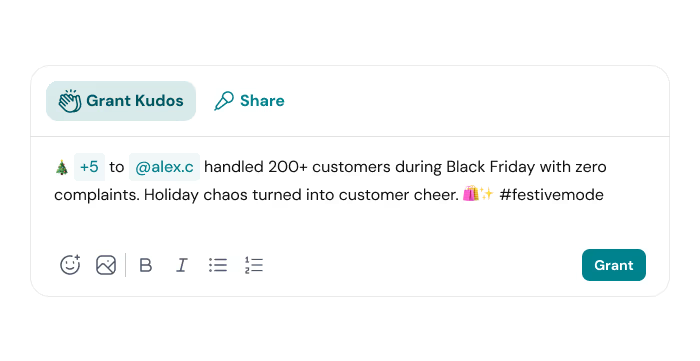Struggling to keep good retail employees? You're not alone. Here's what's happening in retail right now: 66% of employees would quit their jobs if they didn't feel appreciated, according to Forbes research. Nearly 75% of employee turnover is voluntary, and each departure costs you approximately $1,500 in replacement expenses.
But here's something most retail managers miss: there's a solution that's been right in front of you the whole time. Employee recognition. Companies with strong recognition cultures experience 31% lower turnover rates and see employees who are 2.7 times more likely to be highly engaged, according to recent 2025 workplace studies.
This guide reveals which recognition approaches actually move the needle on retail employee engagement, plus specific strategies you can implement immediately to build a workplace where people genuinely want to stay.
The Link Between Recognition and Retail Employee Engagement
Employee engagement isn't just about having happy workers—that's surface level thinking. Real engagement goes deeper, creating emotional commitment and enthusiasm your retail associates feel toward their roles and organization.
What is Employee Engagement in Retail?
Think about your best retail associate—the one who lights up when helping customers, celebrates team wins, and genuinely cares about hitting store goals. That's engagement in action. It's the level of dedication associates exhibit toward their jobs, companies, and customers, deriving personal satisfaction from helping shoppers while feeling emotionally connected to your organization.
Unfortunately, retail faces a massive engagement crisis. Gallup's 2024 data reveals only 30% of employees report being actively engaged at work, while over two-thirds remain either disengaged or actively disengaged. In retail specifically, 34% of frontline employees feel disconnected from their companies.
How Recognition Drives Motivation and Loyalty
Recognition creates powerful psychological impacts that boost both motivation and loyalty. When store associates receive acknowledgment for their efforts, workplace recognition provides them with a sense of accomplishment and makes them feel valued for their contributions.
The numbers tell the compelling story:
- Well-recognized employees are 45% less likely to leave within two years
- Teams with recognition-rich cultures see 31% lower voluntary turnover
- Employees receiving regular praise show 77.9% higher productivity
- Recognized workers are 2.2 times more likely to exceed regular duties
The Cost of Disengagement in Retail
Disengaged employees cost the global economy $8.8 trillion annually—equivalent to 9% of global GDP, according to Gallup's latest analysis.
For retail specifically, disengagement leads to:
- Reduced conversion rates when employees don't encourage browsers to become buyers
- Poor compliance with merchandising and safety guidelines
- Significantly higher turnover
- Diminished customer experiences leading to lost sales and negative reviews
Types of Recognition That Actually Work
Understanding what motivates your retail team requires examining different recognition approaches and their effectiveness in driving engagement.
1. Monetary vs. Non-Monetary Rewards
Financial incentives deliver immediate satisfaction—bonuses, gift cards, commissions, and salary increases pack a punch for many retail employees. Even simple $5 gift cards handed out immediately after exceptional customer service can create powerful impact.
However, research reveals non-monetary rewards often create deeper engagement than cash. Studies show a strong relationship between non-monetary rewards and employee motivation (r = .607), while finding no significant relationship between monetary rewards and sustained motivation.
Lower-level retail employees often rank these non-monetary rewards higher than cash:
- Extra time off or flexible scheduling options
- Professional development and growth opportunities
- Public acknowledgment of achievements
- Additional responsibilities demonstrating trust
- Personal recognition from managers and peers
2. Public vs. Private Recognition
Public recognition happens where others can witness it—team meetings, social media, company communications. Gallup research shows 37% of employees feel stronger recognition culture when it's primarily public, versus just 11% when it's mainly private.
Public recognition works powerfully because it creates learning opportunities. When employees see colleagues getting recognized for specific behaviors, they understand exactly what actions earn rewards, reinforcing culture and keeping recognition top-of-mind.
Private recognition creates personal, one-on-one moments between managers and employees, working best for thanking someone for personal help, recognizing confidential achievements, or supporting introverted team members who prefer avoiding spotlights.
3. Peer-to-Peer vs. Top-Down Recognition
While 40% of workers say manager recognition matters most, peer recognition brings unique advantages. Peer-to-peer recognition creates 35.7% more positive financial impact than manager-only recognition because coworkers truly understand daily retail challenges.
👉 Explore our detailed guide on Employee Recognition Programs covering modern approaches to team appreciation and program implementation strategies.
4. Digital vs. Physical Recognition Methods
Digital platforms offer instant recognition, transparency across locations, and consistent reinforcement of company values. For retailers with multiple locations, digital provides central hubs where everyone can witness recognition happening.
The most effective programs blend digital convenience with personal touches, reaching every employee regardless of their technology comfort level.
Example:

Engage your retail teams with ThriveSparrow—14-day free trial.
Building Recognition Into Your Retail Culture
Companies with strategic recognition programs report 23.4% lower turnover rates and 25.4% better understanding of organizational objectives. [Source: Lumapps]
Here's how to build this culture in your retail organization.
1. Start With Your Company Values
Recognition programs must connect directly to what your company stands for. When employees understand which behaviors reflect core values, they naturally demonstrate those values in daily work.
Create recognition categories mapping directly to each core value, develop "values playbooks" showing what each value looks like in different roles, and train managers to spot and recognize behaviors reflecting company values.
2. Make Recognition Part of Every Day
Recognition can't be occasional—it must be woven into daily store operations. Currently, only 55% of retail workers say recognition is part of their organization's everyday culture.
Think about recognition tools fitting into employees' actual workflows: mobile apps, shared kiosks, or integration into existing communication systems work effectively for retail environments.
3. Address Burnout Through Gratitude
With retail employees facing intense customer pressures and demanding schedules, cultivating workplace gratitude creates powerful mental shifts that combat burnout. When associates regularly express and receive appreciation, it replenishes their depleted emotional resources and builds resilience during challenging shifts.
4. Track What's Working
Monitor metrics that matter: customer service ratings, employee retention rates, program participation, and productivity impact. Listen to employees about what types of recognition actually resonate with them, keeping programs relevant and effective.
Creative Employee Recognition Ideas for 2025
Your employees are tired of generic "employee of the month" approaches. Here's how to recognize people in ways that create lasting impact.
1. Personalized Thank-You Notes
Handwritten notes create something tangible in our digital world. Store managers who write personal notes to employees going above and beyond give them something they'll keep for years. Be specific—call out exactly what they did and why it mattered.
2. Recognition Raffles and Team Outings
Turn recognition into engaging experiences. Set up raffles where employees earn tickets for exceptional performance, holding monthly drawings for prizes like gift cards or schedule priority. Team outings like bowling or escape rooms build camaraderie while celebrating achievements.
3. Social Media Shoutouts and Wall of Fame
Take recognition public by highlighting exceptional employees on store social channels. Inside your store, create walls of fame with photos, manager quotes, and peer testimonials—visual reminders celebrating wins while inspiring others.
4. Flexible Scheduling and Surprise Time Off
Give employees control over their schedules based on performance. Let top performers swap shifts for personal needs or surprise exceptional workers with unexpected time off. These gestures show you value their personal time.
5. Leaderboards for Healthy Competition
Create real-time leaderboards showcasing kudos points and top performers. This transparent recognition system sparks friendly competition, encourages ongoing participation, and brings energy to your workplace culture.

6. Charitable Donations in Employee Names
University of Waterloo research found employees rewarded with charitable donations in their names perform better than those receiving cash rewards. Ask about causes your team supports, then make donations accordingly—aligning recognition with personal values while strengthening corporate culture.
7. Kudos Points Redemption from Favorite Brands
Go beyond standard gifts by letting employees earn “kudos points” they can redeem for rewards from their favorite brands. Whether it’s coffee shop vouchers, streaming service credits, or fitness gear, offering choice empowers employees to pick what truly excites them. This flexibility turns recognition into a personal celebration and shows you appreciate each individual’s interests.

8. Custom Awards and Milestone Celebrations
Generic plaques gather dust—custom awards tell stories. Use symbols reflecting company history and values to highlight accomplishments. Celebrate work anniversaries and career milestones with personalized recognition acknowledging their journey.
If you want to see how ThriveSparrow Kudos works for your retail workers, try it free for 14 days—no credit card required
Case Study: How Top Retailers Are Getting It Right
Let's examine how leading retailers make recognition work effectively, creating cultures where employees genuinely want to stay.
Currys PC World: Revolutionary "Tested in Life" Employee Engagement Program
Currys PC World faced the existential challenge of competing against algorithmic giants like Amazon while maintaining their human-centered competitive advantage. Their solution became one of the most innovative employee engagement programs in retail history.
The company launched their groundbreaking "Tested in Life" initiative, allowing over 700 colleagues to take home popular products—including Google devices, Apple products, Lenovo computers, and Bose audio equipment—for real-world testing and experience. Employees created video diaries and blogs sharing their authentic user experiences on internal portals.
What made this exceptional was how Currys transformed this employee experience into marketing gold. They invited colleagues to audition for TV commercials, featuring real employees like Ahmed, Jules, and Terry in Christmas campaigns that showed them using products at home, then helping customers in-store with that genuine experience.
Results Achieved:
- TV commercials featuring colleagues were significantly more effective at cutting through than traditional ads
- Improved nearly all key diagnostic measures versus previous campaigns
- Achieved the highest brand scores for staff knowledge and helpfulness
- Created authentic customer connections through employee expertise
Source: Marketing Society 2018 Employee Engagement Winner - Currys PC World Case Study
Conclusion
Recognition isn't complicated, but it works when done consistently and authentically. The retailers succeeding in 2025 focus on basics: they recognize their people personally, build appreciation into daily operations, and adapt approaches to individual preferences.
Start wherever makes sense for your team—personalized notes, peer recognition, or simply noticing great work and acknowledging it immediately. Every person who stays instead of quitting saves $1,500 in replacement costs while bringing invaluable knowledge of your customers, systems, and culture.
Ready to transform your retail recognition culture?
ThriveSparrow Kudo's platform is designed specifically for retail environments, featuring instant recognition tools, peer-to-peer appreciation systems, and analytics connecting recognition to business outcomes.
Start your 14-day free trial today—no credit card required.
FAQs
Q1. Why is employee recognition crucial in the retail sector?
Employee recognition is vital in retail because it directly impacts customer experience, reduces costly turnover, and builds workplace cultures where associates feel valued. Recognition motivates staff, increases productivity, and creates environments where employees deliver exceptional customer service naturally.
Q2. What are some effective types of employee recognition in retail?
Effective retail recognition includes both monetary and non-monetary rewards: public acknowledgment, peer-to-peer appreciation, personalized thank-you notes, flexible scheduling, and digital recognition platforms. The key is matching recognition types to individual employee preferences.
Q3. How can retailers create a culture of recognition?
Build recognition culture by aligning appreciation with company values, integrating recognition into daily operations, encouraging peer-to-peer gratitude, and using employee feedback to improve programs. Train managers to identify and acknowledge positive behaviors consistently.
Q4. What are some creative recognition ideas for retail employees in 2025?
Creative 2025 recognition includes personalized handwritten notes, recognition raffles with prizes, team outings, social media shoutouts, surprise time off, custom milestone awards, and charitable donations in employees' names—all tailored to individual and company culture preferences.
Q5. How does employee recognition impact a retail company's bottom line?
Recognition significantly impacts profitability by reducing turnover costs (saving $1,500 per retained employee), increasing sales productivity, and improving customer loyalty through better service experiences. Companies with strong recognition cultures see 31% lower turnover and 23% higher profitability.
















